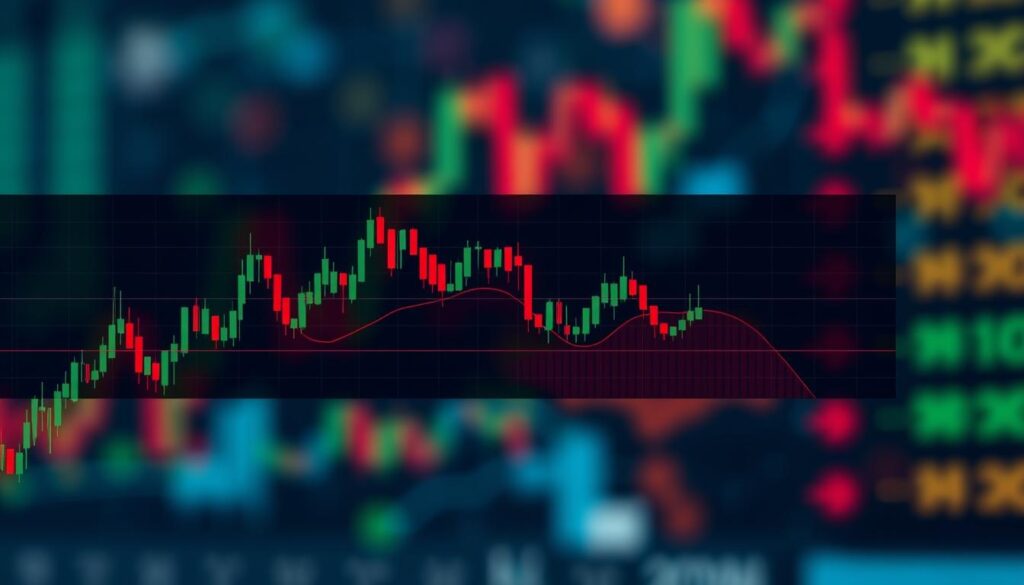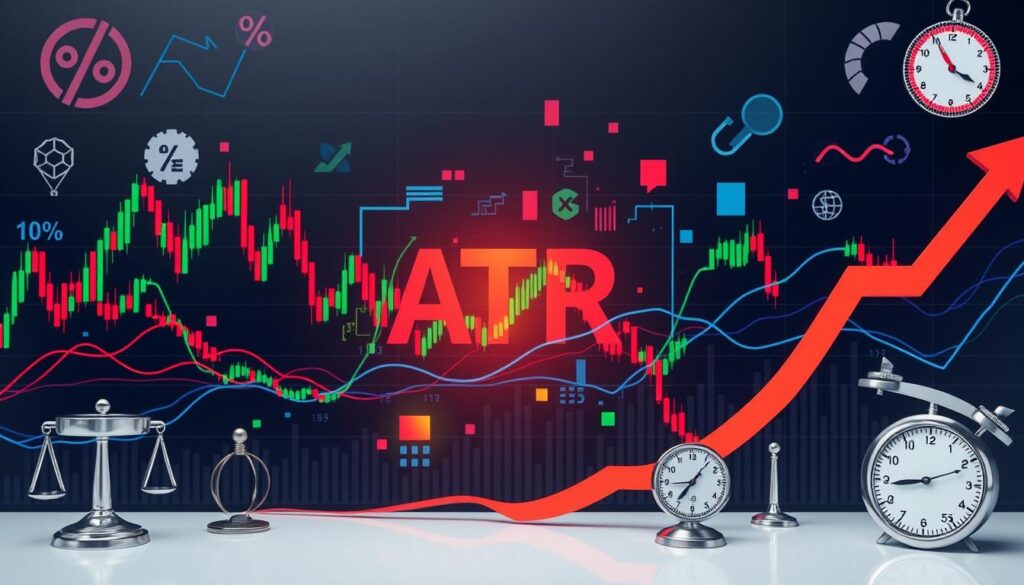The Average True Range (ATR) indicator is a technical analysis tool used to measure market volatility. It was introduced by J. Welles Wilder Jr. and has become a popular tool among traders. The ATR indicator helps traders understand the volatility of a market, which is essential for making informed trading decisions. By using the ATR indicator, traders can gain an edge in various market conditions and improve their trading consistency.
The ATR indicator is typically calculated using a 14-period ATR, with the period adaptable based on individual preferences and the asset being analyzed. This flexibility makes the ATR indicator a versatile tool that can be applied across various financial markets, including forex, stocks, indices, and commodities. Online trading platforms such as IG, MetaTrader 4 (MT4), and ProRealTime offer functionalities to overlay the ATR indicator for easier tracking of market volatility.
Understanding the ATR indicator is crucial for traders who want to improve their trading skills. The ATR indicator can assist traders in reducing emotional decision-making, tailoring risk management to their trading style, adapting to market conditions effectively, and improving trading consistency. With the ATR indicator, traders can set stop-loss orders, determine position sizes, and establish entry signals based on volatility cycles.
Table of Contents
Key Takeaways
- The ATR indicator is a technical analysis tool used to measure market volatility.
- The ATR indicator can be applied across various financial markets, including forex, stocks, indices, and commodities.
- Traders can use the ATR indicator to set stop-loss orders and determine position sizes.
- The ATR indicator can help traders reduce emotional decision-making and improve trading consistency.
- Online trading platforms offer functionalities to overlay the ATR indicator for easier tracking of market volatility.
- The ATR indicator is a versatile tool that can be used in various trading strategies.
- The ATR indicator can be used to establish entry signals based on volatility cycles.
Understanding the Basics of ATR
The Average True Range (ATR) is a widely used indicator for measuring volatility measurement in financial markets. Developed by J. Welles Wilder Jr., ATR basics involve calculating the average range of price movements over a specified period, typically 14 days. This indicator helps traders understand the true range of price fluctuations, which is essential for making informed trading decisions.
ATR values indicate the level of volatility measurement in the market, with higher values suggesting increased price fluctuations. By analyzing ATR values, traders can identify potential trading opportunities and adjust their strategies accordingly. The ATR indicator is often used in conjunction with other technical indicators to enhance trading decisions.
- ATR values can be used to set stop-loss and take-profit orders based on the level of volatility.
- ATR can be used for position sizing to determine the appropriate trade size based on the asset’s volatility.
- ATR can be combined with other technical indicators to enhance trading decisions.
Components of the ATR Indicator for Volatility
The Average True Range (ATR) indicator is a crucial tool for measuring price volatility components in financial markets. It was originally designed by J. Welles Wilder, Jr. for commodities, indicating the degree of price volatility, not price trend. The ATR indicator is calculated based on the true range calculation, which includes the largest of recent period’s high minus low, absolute value of high minus previous close, and absolute value of low minus previous close.
The true range calculation is critical for ATR calculation, as it provides a comprehensive view of price volatility components. The three components of true range calculation are:
- Current high less the current low
- Absolute value of the current high less the previous close
- Absolute value of the current low less the previous close
These components work together to provide a more accurate representation of market volatility. By understanding the price volatility components that make up the ATR indicator, traders can better navigate the markets and make more informed decisions. The ATR indicator is a valuable tool for measuring price volatility and can be used in conjunction with other indicators to form a comprehensive trading strategy.
The ATR indicator is typically measured on a 14-period timeframe for daily data, and it takes a simple moving average of the true ranges over the last 14 periods. By using the ATR indicator, traders can gain a better understanding of price volatility components and make more informed decisions about their trades.
| Indicator | Description |
|---|---|
| ATR | Measures price volatility components based on true range calculation |
| Keltner Channels | Uses ATR to measure bandwidth |
| Bollinger Bands | Implies higher volatility when bands are wider |
How ATR Calculation Works
The ATR formula is a crucial component of volatility calculation, as it helps traders understand market fluctuations. The Average True Range (ATR) is typically based on 14 periods, which can vary from intraday, daily, weekly, to monthly timeframes. To calculate the ATR, traders use the true range, which is the greatest value among today’s high minus low, absolute value of high minus yesterday’s close, and absolute value of low minus yesterday’s close.
The ATR calculation involves determining the true range and then applying a moving average to create the ATR. This process helps traders assess market volatility and make informed decisions. The ATR formula is: ATR = (Previous ATR * (n – 1) + TR) / n, where n is the number of periods or bars, and TR is the True Range. By using this formula, traders can calculate the ATR and use it to set stops or entry triggers, adapting to sharp price moves or consolidation areas to capture abnormal movements.
True Range Calculation Method
The true range calculation is a critical step in determining the ATR. It involves calculating the greatest value among today’s high minus low, absolute value of high minus yesterday’s close, and absolute value of low minus yesterday’s close. This calculation helps traders understand the volatility of the market and make informed decisions.
Moving Average Implementation
The moving average is a key component of the ATR calculation, as it helps smooth out the true range values. By applying a moving average to the true range, traders can create a more stable indicator of market volatility. The most common moving average used in ATR calculation is a 14-period moving average.
Time Period Selection Impact
The time period selected for the ATR calculation can significantly impact the results. Shorter time periods, such as 2 to 10 periods, are used to measure recent volatility, while longer-term volatility is assessed with 20 to 50 periods. Traders can use different time periods to suit their trading strategies and goals.
By understanding how the ATR calculation works, traders can use this indicator to inform their trading decisions and adapt to changing market conditions. The ATR is an invaluable tool for setting stops or entry triggers, and its calculation is based on the true range and moving average. By applying the ATR formula and selecting the appropriate time period, traders can gain a deeper understanding of market volatility and make more informed decisions.
Setting Up ATR on Your Trading Platform
To start using the ATR indicator, you need to set it up on your trading platform. Most online trading platforms have a function to overlay the ATR onto trading charts, making it easy to track volatility in an underlying market without having to calculate the average true range manually. You can find the ATR indicator in the trading platform configuration section, where you can customize its parameters and adjust its visual representation.
The ATR indicator setup is relatively straightforward. You can add the ATR to your charts and adjust the period, usually set to 14, to determine the average true range. This allows you to measure market volatility and make informed trading decisions. Some traders also use the ATR to set profit targets and stop-loss levels, as it provides a clear indication of market volatility.
When setting up the ATR indicator, you can also customize its appearance to suit your trading style. This includes changing the color, line style, and other visual elements to make the indicator more readable. By doing so, you can create a trading platform configuration that works best for you and helps you make the most of the ATR indicator.
Interpreting ATR Values
When it comes to ATR interpretation, understanding the values is crucial for market volatility analysis. The Average True Range (ATR) indicator is a powerful tool used to measure the volatility of a stock’s price movements. Higher ATR values indicate increased volatility, suggesting that prices are moving more dramatically. Conversely, lower ATR values suggest decreased volatility and more stable price action.
To effectively use ATR in trading, it’s essential to understand what high and low ATR readings signify about market conditions and potential price movements. For instance, a high ATR value may indicate a strong trend, while a low ATR value may suggest a consolidating market.
High vs Low ATR Readings
High ATR readings are often associated with increased market volatility, while low ATR readings are associated with decreased volatility. By analyzing ATR values, traders can gain insights into market conditions and make informed decisions about their trading strategies.
Market Condition Analysis
ATR can be used to analyze different market phases, such as trending markets, consolidations, and breakouts. By recognizing patterns in volatility using ATR, traders can anticipate potential price movements and adjust their strategies accordingly.
Volatility Patterns Recognition
Recognizing patterns in volatility is critical for successful trading. ATR can help traders identify periods of high volatility, which may indicate a strong trend, and periods of low volatility, which may suggest a consolidating market. By combining ATR with other indicators, traders can develop a comprehensive understanding of market conditions and make informed trading decisions.
Using ATR for Position Sizing
The Average True Range (ATR) indicator is a valuable tool for determining position sizes, ensuring trades align with your risk tolerance. By using ATR for position sizing strategies, traders can adjust their position sizes based on the volatility of the instrument, leading to smaller positions for more volatile assets and larger positions for less volatile ones.
A key aspect of risk management is determining the appropriate position size. Traders can use ATR to calculate the position size by dividing the risk amount by the ATR value. This approach helps to manage risk effectively and ensures that trades are sized correctly.
Here are some benefits of using ATR for position sizing:
- Adjusts position sizes based on volatility
- Helps to manage risk effectively
- Ensures trades are sized correctly
By incorporating ATR into their position sizing strategies, traders can improve their overall risk management and increase their chances of success in the markets.
| ATR Value | Position Size | Risk Management |
|---|---|---|
| High | Smaller | Conservative |
| Low | Larger | Aggressive |
ATR-Based Stop Loss Strategies
When it comes to setting stop losses, traders often struggle with finding the right balance between risk management and potential profits. One effective approach is to use the Average True Range (ATR) indicator to inform stop loss placement. By incorporating ATR-based exits into their strategy, traders can better navigate volatile markets and minimize losses.
The ATR indicator measures volatility in the market, providing a useful metric for setting stop losses. For example, a trader might set their stop loss at 2-3 times the ATR value above or below their entry price. This approach helps to account for price fluctuations and ensures that the stop loss is not too tight, which can result in premature exits from the trade.
Some popular techniques for using ATR to set stop losses include the fixed ATR multiple method and trailing stop techniques. The chandelier exit, developed by Chuck LeBeau, is another approach that involves placing a trailing stop under the highest high the stock has reached since entering the trade. The distance between the highest high and the stop level is defined as some multiple multiplied by the ATR.
By using ATR-based exits, traders can create dynamic, volatility-based exit points that adapt to changing market conditions. This approach can help traders to stay in profitable trades longer and avoid unnecessary losses. Whether using the fixed ATR multiple method or a trailing stop technique, the key is to find a approach that works for your trading strategy and risk tolerance.
| ATR-Based Stop Loss Strategy | Description |
|---|---|
| Fixed ATR Multiple Method | Set stop loss at 2-3 times the ATR value above or below entry price |
| Trailing Stop Technique | Place trailing stop under the highest high since entering the trade |
| Chandelier Exit | Place trailing stop under the highest high, with distance defined as a multiple of ATR |
Combining ATR with Other Indicators
When it comes to technical analysis, using a single indicator can be limiting. Combining the Average True Range (ATR) with other indicators can provide a more comprehensive view of the market. One popular indicator combination is the composite RSI-ATR indicator, which combines momentum from the Relative Strength Index (RSI) with market volatility from ATR.
This combined indicator aims to provide a more rounded view of the market for decision-making. By incorporating ATR into a trading algorithm, traders can gauge market volatility, leading to potential breakouts in price movements. For example, high ATR values indicate high volatility in the market, suggesting larger price movements, while low ATR values suggest less volatility and smaller price movements.
Some benefits of combining ATR with other indicators include:
- Strengthening breakout signals, especially when ATR values are rising and the price is trending in a specific direction
- Providing a quantitative measure of an asset’s volatility over a specified period, enabling traders to adjust their strategies accordingly
- Assisting in setting effective stop-loss orders by accounting for the average volatility of a cryptocurrency, thus reducing the risk of being stopped out due to normal price fluctuations
Traders can also combine ATR with trend analysis to confirm trends, identify potential reversals, and generate more reliable trading signals. By using technical analysis and indicator combination strategies, traders can make more informed decisions and improve their overall trading performance.
Advanced ATR Trading Strategies
ATR trading strategies are essential for traders to maximize their profits. One such strategy is breakout trading, which involves using the Average True Range (ATR) indicator to confirm genuine breakouts and filter out false ones. By using ATR, traders can quickly gauge the typical market movement in a day to decide on trading signals provided by other indicators.
For example, a trader can use the standard ATR setting of 14 to calculate the average true range over the past 14 periods. This information can be used to assess trading opportunities, including determining whether to trade and where to place stops and limits. Investing in cryptocurrency can be a good example of using ATR to set profit targets and stop losses based on the market’s typical daily movements.
Breakout Trading with ATR
Breakout trading with ATR involves using the indicator to confirm breakouts and filter out false ones. This can be done by using the ATR to set a stop loss above or below the breakout point. For instance, if the ATR is high, the trader can set a stop loss further away from the current price to avoid early closures.
Here are some key points to consider when using ATR for breakout trading:
- Use the ATR to set a stop loss above or below the breakout point
- Set a profit target based on the ATR
- Use the ATR to filter out false breakouts
By using ATR trading strategies, traders can maximize their profits and minimize their losses. It’s essential to remember that ATR is a versatile indicator that can be used in any market condition and timeframe. With the right strategy and risk management, traders can achieve success in the markets.
| ATR Setting | Timeframe | Strategy |
|---|---|---|
| 14 | Short-term | Breakout trading |
| 10 | Medium-term | Trend following |
| 20 | Long-term | Position sizing |
Common Mistakes to Avoid When Using ATR
When using the Average True Range (ATR) indicator, it’s essential to be aware of common ATR pitfalls that can lead to indicator misuse. One of the primary mistakes traders make is relying solely on the ATR indicator for decision-making, rather than combining it with other forms of analysis.
Some common mistakes to avoid include:
- Using the ATR indicator to determine direction, as it does not provide entry points
- Looking for overbought or oversold conditions, as the ATR indicator does not indicate these levels
- Comparing ATR values of different instruments, as values differ for each
- Ignoring the ATR indicator as a tool to filter out false entries
By being aware of these ATR pitfalls and avoiding indicator misuse, traders can use the ATR indicator more effectively as part of a comprehensive trading approach. It’s crucial to remember that the ATR indicator measures market volatility, not price direction, and should be used in conjunction with other technical indicators for informed trading decisions.
Ultimately, a thorough understanding of the ATR indicator and its limitations can help traders avoid common mistakes and make more informed decisions in the market.
| Mistake | Explanation |
|---|---|
| Overreliance on ATR | Using ATR as the sole decision-making tool |
| Misinterpreting ATR values | Confusing ATR values with overbought or oversold conditions |
| Inadequate time frame selection | Choosing a time frame that does not suit the trading strategy |
ATR Trading Examples and Case Studies
ATR trading examples are essential for understanding how to apply the Average True Range indicator in real-world markets. By examining market-specific applications, traders can develop effective strategies for managing risk and maximizing returns. ATR trading examples can be found in various markets, including stocks, Forex, and cryptocurrencies.
When it comes to ATR trading examples, market-specific applications are crucial. For instance, in the stock market, ATR can be used to identify volatile stocks and determine optimal position sizing. In Forex trading, ATR can help traders navigate the volatile currency markets and set stop loss levels. In cryptocurrency markets, ATR can be used to manage risk and identify potential breakouts.
Stock Market Applications
In the stock market, ATR trading examples can be used to identify stocks with high volatility. By using ATR to gauge volatility, traders can adjust their position sizing and stop loss levels accordingly. For example, a stock with a high ATR value may require a larger stop loss level to account for the increased volatility.
Forex Trading Scenarios
In Forex trading, ATR trading examples can be used to navigate the volatile currency markets. By using ATR to identify trends and breakouts, traders can develop effective trading strategies. For example, a rising ATR value may indicate increased volatility, while a falling ATR value may indicate decreased volatility.
Cryptocurrency Market Examples
In cryptocurrency markets, ATR trading examples can be used to manage risk and identify potential breakouts. By using ATR to gauge volatility, traders can adjust their position sizing and stop loss levels accordingly. For example, a cryptocurrency with a high ATR value may require a larger stop loss level to account for the increased volatility.
Troubleshooting Your ATR Analysis
When using the Average True Range (ATR) indicator, traders may encounter issues that affect the accuracy of their analysis. ATR troubleshooting is essential to resolve these problems and optimize the indicator’s performance. One common issue is inconsistent ATR values, which can be addressed by adjusting the period setting or using multiple ATR indicators with different settings.
To improve the effectiveness of ATR, traders should focus on indicator optimization. This involves experimenting with different period settings, such as 14, 20, or 22, to find the one that works best for their trading strategy. Additionally, traders can use ATR in combination with other indicators to validate signals and improve the accuracy of their analysis.
Some key considerations for ATR troubleshooting and optimization include:
- Adjusting the period setting to increase or decrease sensitivity to price movements
- Using multiple ATR indicators with different settings to confirm signals
- Combining ATR with other indicators, such as moving averages or trend lines, to improve analysis
- Monitoring ATR values to identify changes in market volatility and adjust trading strategies accordingly
By following these tips and continuously refining their approach to ATR analysis, traders can improve their trading performance and make more informed decisions.
Conclusion
As we reach the conclusion of this comprehensive ATR trading guide, it’s clear that this versatile indicator is a powerful tool for volatility analysis and trading strategy development. The ATR has been used by professional traders for decades to enhance their trading results, providing valuable insights into market conditions and price movements.
Throughout this article, we’ve explored how the ATR can be utilized to set effective stop-loss levels, manage position sizing, and identify potential breakout opportunities. By understanding the cyclical nature of volatility, as exemplified by the Bollinger Bands technique, traders can better time their entries and exits to capitalize on significant price moves, such as the example of Monster Beverage Corporation doubling in price within four months after a breakout from low volatility.
Integrating the ATR into your trading approach requires a thoughtful, holistic approach, considering factors like market context, news impact, and trading timeframes. Whether you’re a day trader or a long-term investor, monitoring the ATR can help you prepare for potential turbulent market conditions and adjust your risk exposure accordingly.
As you continue to develop your skills in volatility analysis and ATR application, we encourage you to explore further resources, such as Toby Crabel’s groundbreaking work, which demonstrated the effectiveness of using ATR across various commodities and financial futures. Remember, mastering the ATR is an ongoing process, but with diligence and a commitment to continuous learning, you can unlock the true power of this invaluable trading tool.
FAQ
What is the Average True Range (ATR) indicator?
The Average True Range (ATR) is a technical analysis indicator that measures the volatility of a financial instrument by calculating the average of the absolute values of the differences between the current period’s high and low, and the previous period’s close.
Why is understanding volatility important in trading?
Volatility is a crucial factor in trading as it can significantly impact trading strategies, position sizing, and risk management. The ATR indicator provides traders with a unique perspective on market movements and helps them make more informed decisions in various market conditions.
How is the true range calculated in the ATR indicator?
The true range is calculated as the maximum of the following three components: the current period’s high minus the current period’s low, the absolute value of the current period’s high minus the previous period’s close, and the absolute value of the current period’s low minus the previous period’s close.
What is the impact of different time periods on the ATR value?
The choice of time period for the ATR calculation can have a significant impact on the indicator’s values. Shorter time periods can lead to more frequent signals, while longer time periods may provide a smoother, more stable indicator. Traders need to select the appropriate time period based on their trading style and market conditions.
How can traders use the ATR indicator for position sizing?
The ATR can be used to determine appropriate position sizes based on the volatility of the market. By calculating position sizes using a fixed percentage of the ATR, traders can maintain consistent risk levels across different markets and timeframes, helping to manage their overall risk exposure.
What are some common strategies for using the ATR to set and manage stop losses?
Traders can use the ATR to set initial stop losses based on a fixed multiple of the ATR value. They can also use the ATR to implement trailing stop loss strategies, such as the chandelier exit, which adjusts the stop loss level based on changes in market volatility.
How can the ATR indicator be combined with other technical tools?
The ATR can be effectively combined with other technical indicators, such as moving averages, RSI, and MACD, to confirm trends, identify potential reversals, and generate more reliable trading signals. Analyzing indicator divergence with the ATR can also help traders spot potential market turns.
What are some common mistakes traders make when using the ATR indicator?
Common mistakes include over-relying on a single indicator, misinterpreting ATR values, and using inappropriate time frames. Traders should avoid these pitfalls by combining the ATR with other forms of analysis and always considering the broader market context.
How can traders troubleshoot issues when using the ATR indicator?
Traders may encounter problems such as ATR values that seem inconsistent with market behavior or difficulties in interpreting ATR in different market conditions. The guide offers practical tips for optimizing ATR settings, validating ATR signals, and adjusting analysis techniques for various market environments.









